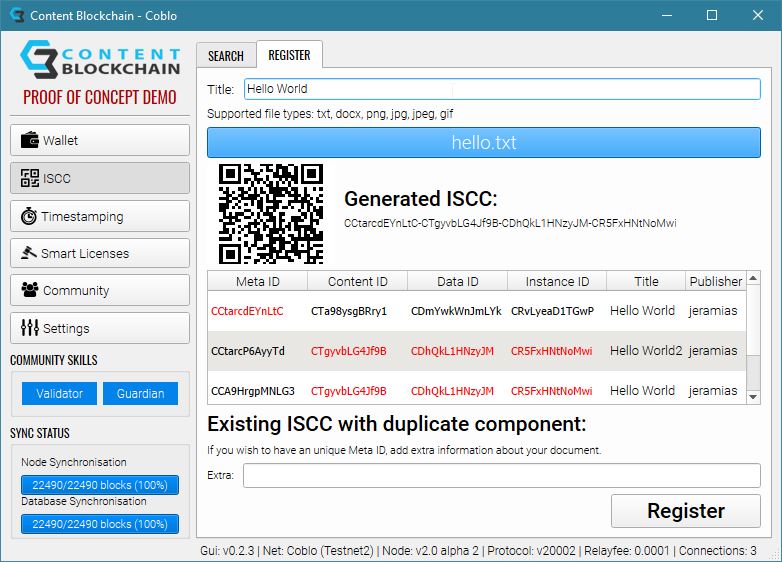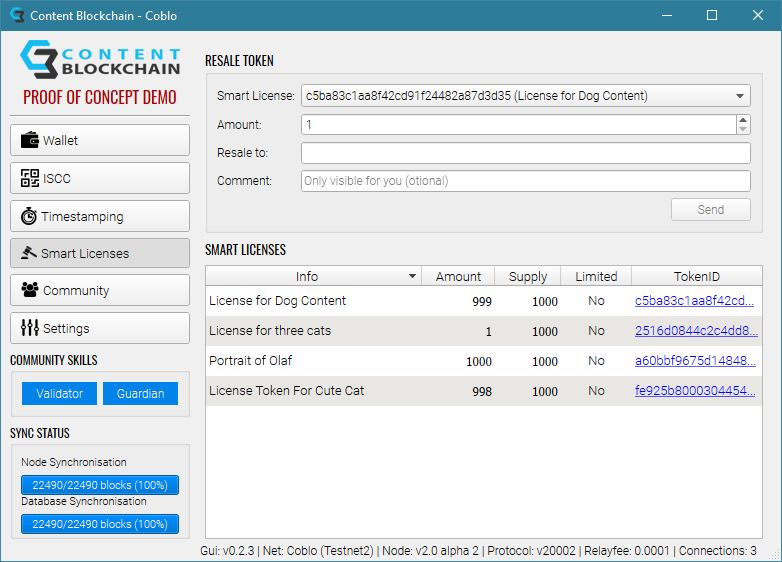A proof of concept GUI Application for the Content Blockchain.
The Content Blockchain Project is building the foundational tools that enable journalists, publishers, and media start-ups to create new innovative products, services and business models in the open blockchain economy.
This software allows you to run a full content blockchain node on your computer and participate in testing the plattform. It allows you to:
- run your own blockchain-node (testnet)
- create an account on the blockchain
- test the experimental voting based consensus
- send and receive native blockchain coins
- timestamp content on the blockchain
- search, create and register ISCC content identifiers
- send and receive smart license tokens
An installable version is currently available for 64-Bit Windows. You can download it here. If you need help or have questions you can reach us via Telegram: https://t.me/ContentBlockchainBeta
Please report any issues at https://github.com/coblo/gui-demo/issues
Wallet
Content is registered via transactions that are replicated and stored on the blockchain. Infrastructure providers are rewarded with native currency (CBL) for their services. The wallet screen shows your balance and transaction history. You may exchange CBL with other participants.
ISCC
The ISCC is an open and decentralized digital media identifier. You can search for content registered with an ISCC and generate/register new ISCCs for text and image content. When generating a new ISCC you will also see if your content or similar content has been registered before.
Smart Licenses
Here you can send an recieve smart license tokens. These are custom tokens that allow you to own and resell a license as if it were a physical object. Smart Licenses and corresponding tokens can be generated with our Smart License Web Demo.
Timestamping
A minimal demonstration of simple content timestamping. Here you can create, search and optionally register a unique cryptographic fingerprint (SHA256 hash) of any document or file. You may also add a short comment to your timestamp entry on the blockchain.
Community
Demonstration of a decentralized voting based governance. Participants that operate full nodes on the network can become Validators and earn tokens for their services. Guardians determine Validators by on-chain voting.
If you want to contribute or just play around with the code you will need Python 3.5 on your system. The application is cross platform and should generally work on any 64-Bit Linux, Mac or Windows. Please be aware that this is a "Proof of Concept" and the code is not meant to be production grade. These are the steps to get your hands dirty:
- Checkout this repository to you machine
- Optionaly create a virtual environment for the project
- Install python dependencies with
pip install -r requirements.txt - Download multichaind binaries and place them in
/app/bin - Compile QT .ui files with
comile_ui.py
Now you should be able to run main.py. Launching the application will check
if you have a profile.db SQLite file in your systems app data folder.
For example on Windows that would be C:\Users\YOURUSERNAME\AppData\Local\Content-Blockchain\Coblo\profile.db.
If that file does not exist the application will guide you through the setup wizard
to create a profile.db and a blockchain address.
By default the application will manage the multichaind node proccess.
For development you might want to manage the process yourself.
See runchain.example.bat for how to manually start a MultiChain node on Windows.
The first time setup wizard also allows to specify connection data for you
manually managed node.
By installing the requirements-dev.txt dependencies you will also be able to
create frozen app builds and edit .ui files with QT-Designer. The Windows
build/dist is created with python setup.py bdist_msi. pyqt5-tools will
install the QT-Designer executable to your python site-packages/pyqt5-tools
folder.
The Content Blockchain Project received funding from the Google Digital News Initiative.
This application was build with Python, PyQT, MultiChain, and many other open source libraries and tools. Our thanks go out to the entire open source community.




